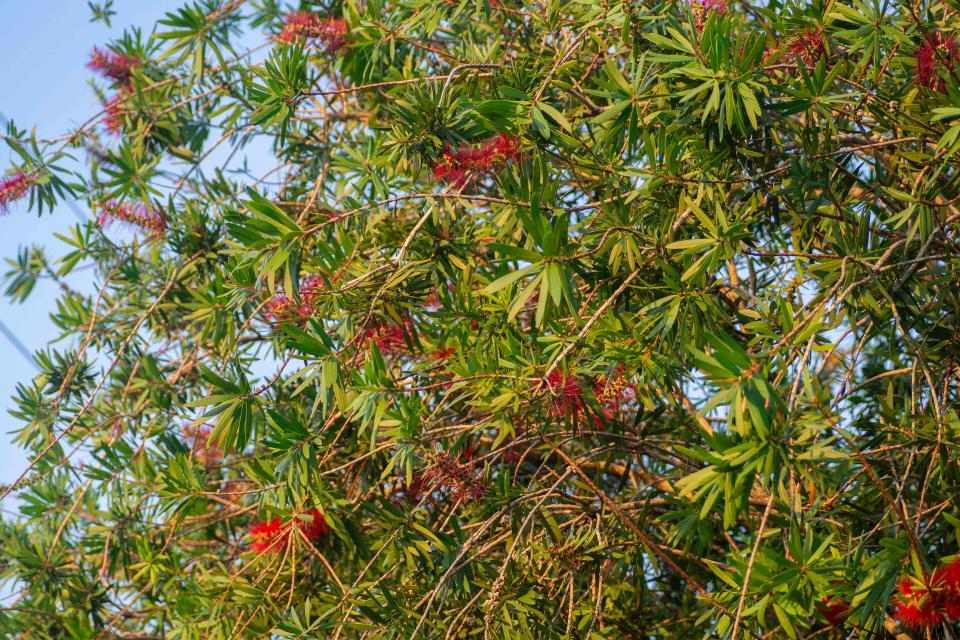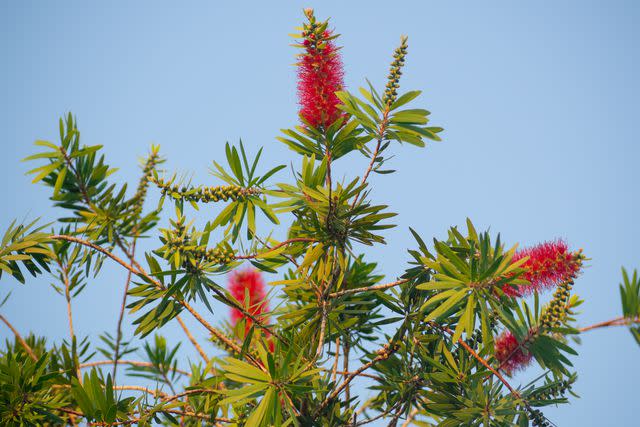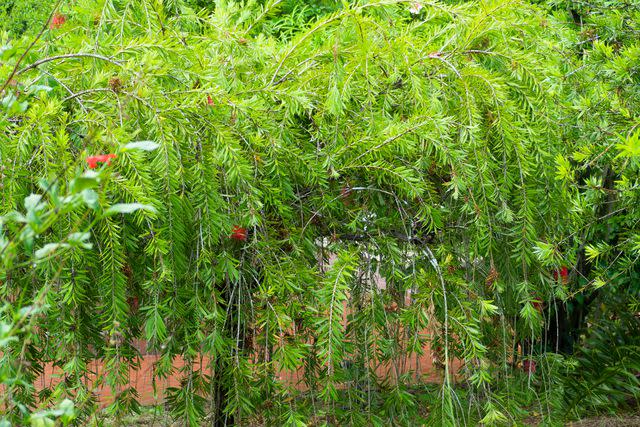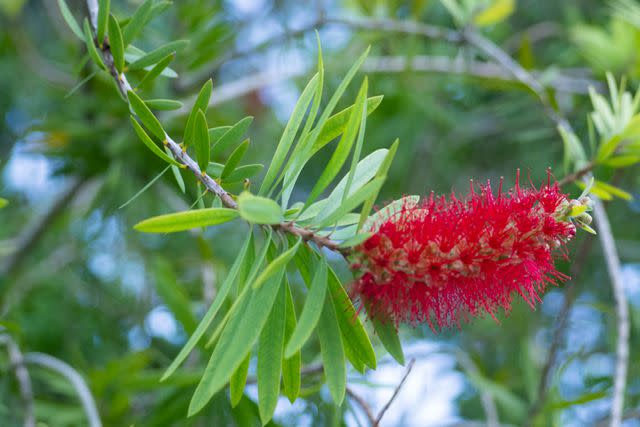How To Grow And Care For Bottlebrush
This colorful bloomer will bring the drama—and the hummingbirds!

Southern Living/Valerie de Leon
Fact checked by Khara Scheppmann
Gardeners in the Coastal and Tropical South love the fast-growing bottlebrush for its colorful flowers, which can be dense spikes or round clusters with long, bristle-like stamens—hence the name bottlebrush. Hummingbirds love the flowers, too, which are followed by woody capsules that can last for years and resemble rows of beads pressed into bark.
Some bottlebrushes are naturally dense and compact making good informal hedges; others are sparse and open (they can be pruned up to become small trees). Those with pliant branches can be grown as informal espaliers. Many grow quickly to 10 or 15 feet tall, while other varieties only grow to 3 feet.
Now classified as Melaleuca species, bottlebrush is often still labeled as Callistemon. Found in moist ground in their native Australia, bottlebrush can't withstand waterlogged soil. This plant is usually tolerant of salt and slightly alkaline soils but sometimes can suffer from chlorosis or yellow leaves with green veins. Bottlebrush can be severely damaged in freezing temperatures. You can plant it any time of year in a mild climate, but should wait until after the last frost in spring in the northern part of its range.
Common Name | Bottlebrush, crimson bottlebrush, lemon bottlebrush, stiff bottlebrush, prickly bottlebrush |
Botanical Name | Melaleuca spp. (previously Callistemon) |
Family | Myrtaceae |
Plant Type | Tree, shrub |
Mature Size | 3-15 ft. tall, 3-15 ft. wide |
Sun Exposure | Full |
Soil Type | Well-drained, moist |
Soil pH | Slightly acidic to slightly alkaline (6.0-8.0) |
Flower Color | Red, pink, yellow, white |
Hardiness Zones | 8B–11B (USDA) |
Native Area | Australia |

Southern Living/Valerie de Leon
Bottlebrush Care
Usually purchased as a flowering shrub, bottlebrush can be shaped into espalier or pruned to take on a tree form. Plant bottlebrush in well-drained soil in full sun in Coastal and Tropical South gardens. To plant, dig a hole two or three times wider than the rootball. First amend the soil you've dug up to improve drainage if needed. If you have sandy soil that is poor in nutrients, mix in a little organic matter such as compost. Replace the soil around the plant and water deeply. Spread mulch around the new plant. Bottlebrush has high-drought tolerance once established and requires little care as long as it receives sunshine and soil that drains well.
Light
Bottlebrush needs full sun, or at least six hours every day, to bloom. If planted in shade or crowded by taller plants that block the sun, consider moving the bottlebrush or trimming back other tall plants. Bottlebrush puts on a colorful show in the garden and shorting it on sunshine will limit its beauty.
Soil
Bottlebrush isn’t picky about the type of soil, but it needs to drain well. If it becomes water-logged, disease can set in. Conversely, if water can’t penetrate heavy soil, the roots won’t receive the deep water they need. Mix in compost and/or shredded leaves to improve drainage in clay. Planting in a raised mound can also help improve drainage.
Bottlebrush can suffer in very alkaline and very poor, sandy soils; if this describes your garden soil, work in a bit of organic matter to help retain moisture and aluminum sulfate or peat to reduce the pH.
Water
Bottlebrush needs minimal care once established. If the climate is dry or rainfall levels are low, supplement with good waterings to provide moisture for the first year as the root system becomes established. Water deeply and allow the soil to dry out slightly in between waterings. Water established plants during periods of drought, especially if you notice wilting leaves. Supplemental watering is less necessary in winter while the plant isn't actively growing.
Temperature And Humidity
Bottlebrush likes the heat and can grow in a humid climate as long as its soil drains well and isn't soggy. This plant can also do well in arid climates, but it is not a desert plant. Bottlebrush benefits from watering during long dry spells. As it is moderately salt-tolerant, bottlebrush is a good choice for coastal gardens.
Most bottlebrush varieties survive winters in Zone 8b or 9, though some cold-hardy types are now available for Zone 7. Though bottlebrush is evergreen, frost can damage or kill the foliage.
Fertilizer
Fertilizing bottlebrush can help maintain its health, encourage growth, and keep the leaves a nice, dark green. Apply a slow-release tree fertilizer in early spring and a second time in late spring or early summer, following package directions on the amount to apply. Don't fertilize within two months of your first fall frost date, as new growth can be damaged by frost.
Bottlebrush can develop chlorosis, when new leaves turn yellow due to a lack of iron. This is most common in soil that is too alkaline. If you experience this, use a fertilizer that contains sulfur and/or iron to help green the plant (many fertilizers for acid-loving trees and shrubs contain sulfur). You can also have your soil tested by the local extension office and follow any recommendations for adjusting soil pH or providing more nutrients.
Types Of Bottlebrush
Bottlebrush plants may be labeled as Melaleuca or under the old species name of Callistemon. There are many species, but not all are commonly available in the U.S. Some specialty nurseries may have more types available. Here are a few common bottlebrush varieties:
M. citrina 'Scarlet Compacta' grows to 12 feet tall and 10 feet wide and has long, scarlet brushes. It must be planted in Zone 10 or 11. 'Little John' is a dwarf variety of M. citrina (crimson or lemon bottlebrush, which has leaves that release a citrus scent when crushed) with bluish foliage and shorter flower spikes. 'Little John' grows to 3 feet tall and wide and is cold-hardy to Zone 8a.
M. viminalis 'Neon Pink' has an upright form, hot pink flowers, and gray-green foliage. It grows 8-12 feet tall and slightly less wide. Slim™ of the same species has a multi-stemmed, almost weeping form that grows to 10 feet tall and 4 feet wide. Both are cold-hardy to Zone 8.
Light Show® is a Southern Living variety with spiky, upright growth that emerges light green and then darkens. It bears short, red brushes and grows to 5 feet tall and 4 feet wide. This plant is cold-hardy to Zone 8b.
'Semmes Hardy' and 'Woodlanders Hardy' are similar varieties with an arching form and citrus-scented leaves. Foliage emerges copper-colored and then turns green. Both have red bottlebrushes and grow to about 5 feet tall and wide, and both are cold-hardy to Zone 7b.

Southern Living/Valerie de Leon
Pruning
Very little routine pruning is needed—just remove any weak or dead branches after bloom or before spring growth. You can also lightly prune your shrub to shape it. Don't cut into bare wood beyond leaves; if you do, bottlebrush may not send out new growth. Bottlebrush blooms intermittently all year, so consider pruning after late spring or summer flowers. Remove suckers from the trunk periodically.
More extensive pruning to control the plant's size is best done in late winter before the shrub begins actively growing.
Propagating Bottlebrush
Bottlebrush trees can be propagated with cuttings from semi-mature tips of branches in summer (note that propagation of patented varieties is not allowed). This method will give you a plant identical to the mother plant, and results in faster maturation and blooming than growing from seed.
Using clean pruners, take 6-inch cuttings from semi-mature bottlebrush wood (avoid new, very green stems). Remove any flower buds and pinch off lower leaves, leaving a pair of leaves on the tip. Dip the cut ends into hormone powder and stick into 6-inch pots filled with a lightweight mixture of peat moss and perlite. Water well and then cover with a clear plastic bag, making certain the plastic doesn't touch the foliage.
Set in a warm spot with plenty of bright, indirect light, and remove the plastic on occasion for ventilation. After four weeks, give the cutting a gentle tug to see if it is well-rooted. Rooted cuttings should be repotted in potting mix and exposed to more sunlight. Keep in a warm, sunny spot like a window until all danger of frost has passed, then gradually expose plants to the outdoors before transplanting.

Southern Living/Valerie de Leon
How To Grow Bottlebrush From Seed
Bottlebrushes can be grown from seeds harvested from your trees. The resulting plants are often hybrids that don't exhibit the same traits as the mother plant and take about three years to start blooming. Seeds take a long time to mature, so don't use new seed pods from the growing tips of the plant. Instead, select two-year-old seed capsules lower down on the branches. Sow the tiny seeds in spring when the weather is beginning to warm up, following these steps:
Take seed pods indoors, put them in a paper bag, and store in a warm spot. The seed pods should open over the next few days.
Fill a tray or small containers with peat-based seed-starting mix and moisten.
Sprinkle the tiny seeds on the seed starting mix and wet them down with a spray bottle.
Cover the containers with clear plastic and set in a warm, bright spot such as a greenhouse or near a window indoors. Mist the containers with the spray bottle to keep moist.
After seedlings sprout in a couple of weeks, remove the clear plastic, but continue to keep moist by spraying.
Seedlings can be repotted in larger containers once they reach a few inches in height. In fact, you can continue to grow the plants in containers on your patio until next year's growing season. Once all danger of frost has passed, harden off the plants by gradually exposing them to the outdoors over the course of a week.
Once seedlings reach a suitable size, transplant them in the garden.
Potting And Repotting Bottlebrush
Many gardeners like to grow bottlebrush in pots, as it allows you to bring them indoors during periods of frost. Smaller varieties work best in containers. Choose a container with drainage holes that allows plenty of room for the roots to grow, at least 8 inches wider or as much as double the size of the original container. Use a mixture of 4 parts well-draining potting mix and 1 part perlite, grit, or pumice. When planting the shrub, place it so that the top of the root ball is level with the potting mixture. Cover the soil with a thin layer of wood chips.
Bottlebrush plants need more frequent watering in pots and will benefit from fertilizer during the growing season. Repot the plants after two to three years, or when the roots have filled the pot and the plant starts drying out quickly.
Overwintering
Though bottlebrush can survive frosts, severe weather damages the foliage. This plant also has a hard time surviving wet soils in winter, so planting in well-draining soil is critical. Mulch the base of the plant to protect the roots from temperature extremes. Covering the plant with frost cloth during cold snaps can protect the foliage. Shake excessive snow or ice off of branches to help prevent snapping. And finally, if your bottlebrush dies back during a severe winter, wait until the growing season before pruning as new growth may emerge.
Common Pests & Plant Diseases
Bottlebrush is not susceptible to many pests but can be infested by scale. The insects move very little and appear to have a brown "armor" or shell. With a minor infestation, you can simply remove foliage that has scale and dispose of it so the insects don't continue to spread. Horticultural oil can help with more serious infestations.
Root and crown-attacking fungi can be a problem if the soil is overly moist, as can twig gall. If new branch growth looks bloated, remove growth and allow the soil to dry. To prevent disease, make sure bottlebrush has good air circulation and keep the plant on the dry side.
How To Get Bottlebrush To Bloom
Bottlebrush blooms best in full sun with at least six hours of direct sunlight per day. Young plants grown from seed or cuttings will take a few years to start blooming. If neither of these are a factor, consider if you may have pruned the tree in spring while it was setting buds. It's best to wait until after blooming to prune. Finally, severe droughts can affect blooming. Make sure to water your bottlebrush during long dry spells.
Common Problems With Bottlebrush
Bottlebrush is considered a low-maintenance plant but can develop some problems, especially in wet climates or poor, sandy soils. Here are a few things to watch out for:
Dead Branches
Frost can damage the foliage and even kill entire branches in a harsh winter. In a humid climate, excessive rain or overly wet soils can cause rot, eventually leading to sections of the plant dying out. Prune off dead branches and give the plant time to fill in bare spots with new foliage. Reduce watering or improve drainage if moisture is an issue.
Underwatering during dry weather can also lead to dry, crispy leaves, especially on a younger plant.
Yellow Leaves
Yellow leaves could be a sign of overwatering or of nutrient deficiency. Have your soil tested to see if enough iron and magnesium are available to the plant. Alkaline soil can also cause chlorosis because it makes nutrients unavailable to the plant. A fertilizer for acid-loving trees and shrubs may help. You can also spray the plant with chelated iron to green up the leaves. Again, it's a good idea to have your soil tested and follow the guidance of your extension office.
Frequently Asked Questions
How long does bottlebrush live?
Bottlebrushes can live for 50 years in a suitable environment, but often only live 20-40 years.
What's the difference between bottlebrush and bottlebrush plant?
Bottlebrushes (Melaleuca spp.) are Australian native evergreen shrubs and trees with fine foliage and bristly flowers. Bottlebrush plant, or Japanese burnet (Sanguisorba obtusa), is a clumping, deciduous perennial with serrated leaves and pink bottlebrush flowers.
Is bottlebrush a messy plant?
The fine bristles of bottlebrush flowers can be messy. Don't plant this tree near a pool or other areas you want to be free from debris.
For more Southern Living news, make sure to sign up for our newsletter!
Read the original article on Southern Living.

